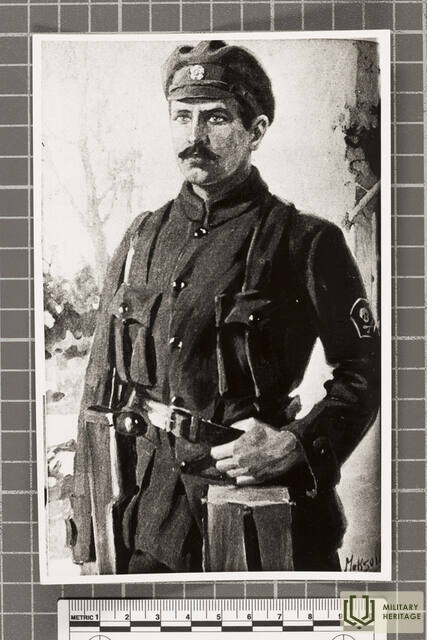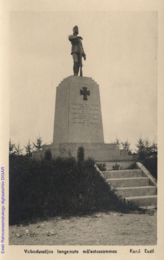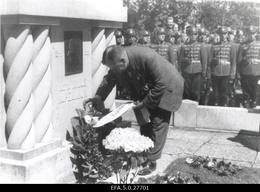Julius Kuperjanov (1894-1919)
I World War I, I Wars of Independence
Estonian military officer, commander and a hero of the War of Independence. Cross of Liberty 1st Class 2nd Rank and 2nd Class 3rd Rank recipient (posthumously).
Julius Kuperjanov was born on 11 October 1894 to a family of Estonian emigrants living in the Governorate of Pskov. In 1904, the family returned to Estonia and settled in Tartu County.
Kuperjanov was drafted during the First World War by the Imperial Russian Army in 1915. He attended the 4th Vladimir Military School in Saint Petersburg. He excelled in his subsequent military service for his bravery and went on to receive seven Russian military decorations. He was wounded in July 1917 and was evacuated to Moscow.
In November 1916, Kuperjanov was promoted to the rank of lieutenant. In November 1917, he was relocated to Tartu to serve as junior officer and head of a company in the Estonian Replacement Battalion. In December, he was promoted to Assistant Head of the Battalion.
After the German occupation of Estonia, the Estonian army was disbanded with personnel being made redundant. During the German occupation in 1918, Kuperjanov secretly organised underground home guard units which later became the basis for the establishment of the Defence League.
At the start of the War of Independence, Kuperjanov was appointed Regional Head of the Defence League in Tartu County. After the capture of the town of Tartu, Estonian forces fell back to Puurmani Manor. There, during Christmas in 1918, he formed a military unit from volunteer older pupils and members of the Defence League, the so-called Kuperjanov Partisan Battalion named after him, which gained a lot of popularity.
His was the first of the military formations to attack in the liberation of Tartu on 14 January 1919, storming in on armoured trains. The advance continued onwards to Valga. Kuperjanov was badly wounded in the Battle of Paju near Valga on 31 January and died on 2 February 1919 in Tartu. Commander-in-Chief of the Estonian Armed Forces General Johan Laidoner officially named the battalion First Lieutenant Kuperjanov Partisan Battalion in honour of the fallen commander. Today, one of the military units of the Estonian Land Forces bears the name Kuperjanov Infantry Battalion.
Alice, née Johanson, the wife of Julius Kuperjanov, was one of the founders and contributors of the Women's Voluntary Defence Organisation. She was deported in 1941 and executed in 1942 in the Soviet Union.
Related objects
Monument to the War of Independence in Puurmani
This monument is situated just outside the small borough of Puurmani on the Puurmani-Tabivere road.
Designed by Voldemar Mellik, it was unveiled on 26 September 1926 and depicted a Kuperjanov partisan resting on his gun on top of a granite plinth. The bronze statue went missing during the Soviet era. The plinth was blown up and the mound it stood on was levelled in 1948. A Red Army monument was installed in lieu, which was replaced in 1970 with a monument to the Great Patriotic War. The restored version of the original monument, made by Kadri Metsik, was unveiled anew on 23 June 1992. A new park has been planted around the monument whose trees have been named after those who fell in the War of Independence and other prominent figures from Kursi parish.
Sources:
National Heritage Board registry of cultural monuments. https://register.muinas.ee/public.php?menuID=monument&action=view&id=27111
Tomb of Lieutenant Julius Kuperjanov
This monument is situated in Raadi Cemetery in Tartu, to the left of the main pathway in the section near Kruusamäe Street.
The tombstone of War of Independence hero Lieutenant Julius Kuperjanov was designed by renowned Estonian sculptor Jaan Koort and unveiled on 11 October 1925. During the Soviet era, the bronze low-relief and the texts on the monument were removed. The tombstone itself was not demolished, however, and it became a symbol of resistance against the foreign regime, with flowers and candles secretly being placed there. The monument has been restored to its original state.
Related stories
The beginning, course and conclusion of the Battle of Cēsis
The victory in the Battle of Cēsis was destined to become a turning point in the Latvian and Estonian struggle for the independence of their country. This victory put an end to the plans of the Andrievs Niedra government and the German general Rüdiger von der Goltz to conquer the Baltics. Instead, the Latvian Provisional Government of Kārlis Ulmanis resumed its activities in Liepāja.








